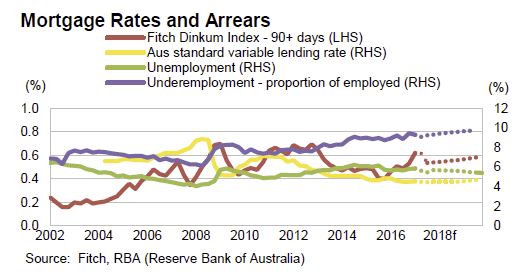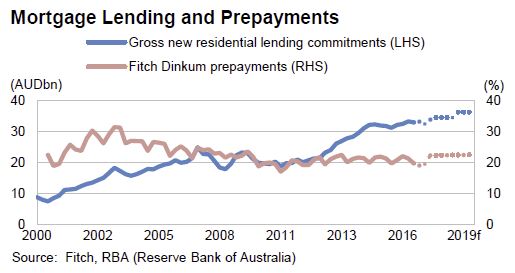Globally, national house prices are forecast to rise this year in 19 of 22 markets highlighted by Fitch Ratings in a new report, but growth is expected to slow in most markets and risks are growing as the prospect of gradually rising mortgage rates comes into view this year. Their data on Australia makes interesting reading.
Home Prices: Growth Decelerates
Combined capital city home prices showed yoy growth of 6.6% in the year to November 2017, down from 10.9% over the year to December 2016. The increase was driven by Hobart (+12.7%), Melbourne (+11.0%) and Sydney (+7.7%). Melbourne and Sydney experienced slower growth while Hobart experienced faster growth than a year earlier. Continued record low interest rates have supported price growth while gross rental yields slipped to a record low of 3.6% as of October 2017. Tighter lending standards and foreign ownership restrictions have dampened price growth however.
Fitch expects Sydney and Melbourne HPI to stabilise in 2018, due to low interest rates, falling rental yields, increasing supply, limited investment alternatives and growing dwelling completions, partially offset by high population growth.
Affordability: First-Home Buyers Back in the Market FTBs increased to 17.4% of owner-occupied lending in September 2017 from 13.1% in September 2016, after FTB grants were introduced in New South Wales and Victoria in July 2017. The state governments of Australia’s two most populous states have introduced new FTB support, such as abolished stamp duty for properties up to AUD650,000, reduced stamp duty for properties up to AUD800,000, and grants of up to AUD20,000 for the building of new homes.
Although FTB activity has increased since the announcement of the FTB changes, affordability is still a key issue for FTB. This is particularly true in major cities, as wage growth falls behind HPI.
Fitch expects the increase in FTB to be temporary; low income growth, tighter underwriting and rising living costs will maintain pressure on affordability for FTB. As mortgage rates are currently low, any material rate rise will weigh further on mortgage affordability and serviceability.
Mortgage Performance: Low Arrears to Continue
Mortgage arrears remained broadly stable in 1H17. This is despite lenders increasing mortgage rates, particularly for investment and interest-only loans, while the RBA has made no change to the cash rate. As at 3Q17, 30+ days arrears for prime RMBS were 1.02% according to our Dinkum RMBS index, compared with 1.09% at end-2016. The level of under-employment in Australia stabilised at 9.1% of employed persons in 3Q17 (9.2% in 3Q16), and this may be affecting the disposable income and servicing capacity for some borrowers.
Fitch expects mortgage performance to remain stable in 2018, as interest rates stay low. Fitch believes the adoption of APRA-prescribed serviceability practices by lenders in 2016 has improved borrower ability to service mortgage loans originated since then. However, the rising cost of living and sluggish wage growth are likely to increase pressure on recent borrowers who have little disposable income.
Mortgage Lending: Slower Growth. New mortgage lending growth has slowed in 2017 compared to end-2016, against a background of modest economic growth and reduced investment lending. Home sale transactions decreased in the year to October 2017 by 4.7% nationally (as per CoreLogic); combined capital city sales were 6.0% lower and combined regional market sales were down 2.2%. Lower investor demand, increasing transaction costs, higher capital requirements for banks, further prudential measures restricting lending to investors and stricter serviceability parameters, have restricted access to mortgages for some borrowers.
Fitch expects mortgage lending growth to slow to around 4% in 2018, based on continued record low interest rates and stable unemployment. This will once again be offset by continued underemployment, reduced investor demand and tougher lending practices.
Regulatory Environment: New Measures Introduced
In March 2017, the Australian Prudential Regulation Authority (APRA) announced additional supervisory measures to moderate investment lending in Australia. The APRA expects authorised deposit-taking institutions (ADI) to limit new interest-only lending to 30% of originations; limit growth in investment lending to 10% per year; ensure that serviceability metrics are set at “appropriate levels for current conditions”; and to continue to restrain lending growth in high-risk segments such as high loan-to-income loans, high LVR loans, and long tenure loans. The recently introduced measures relating to interest only lending have already been adopted by lenders and, along with the other restrictions brought in over the past two years, are reflected in the increased pricing of interest only and investment loans.
In July 2017, ownership restrictions were applied in New South Wales and Victoria; a 50% cap on foreign, non-resident ownership in new developments; a levy on foreign, non-resident investors whose properties are vacant for at least six months in a calendar year; increasing the capital gains tax (CGT) withholding rate to 12.5% from 10.0% and increasing the threshold for CGT to AUD2 million from AUD750,000. On 17 July 2017, the Treasury released draft legislation proposing that APRA extend its remit to regulate lending activities of non-ADIs.
Fitch expects the additional regulatory supervision measures to reduce the supply of lending to investors and moderate the house price growth in Sydney and Melbourne in 2018.
They say tighter mortgage regulation, record low rental yields, and increasing supply will slow Australian price growth. FTBs in Sydney and Melbourne received government support in 2017, but the impact is expected to be temporary, considering affordability pressure. Australia and New Zealand will post small rises in arrears as home prices in big cities stabilise.
Australia and the US have had nominal home price growth rates since 2010 of 41% and 32%, respectively, that have been substantially higher than rental growth rates. This has occurred despite a high rental growth of 19% in both countries over this period. Australia’s rental growth rate has flattened since 2016, while the rental growth for the US has been accelerating since then.
Australian housing completions have again been the highest of the countries covered. This has put downward pressure on prices in several cities and regions outside of Sydney and Melbourne, although immigration has kept the ratio per 1000 citizens more stable. In Sydney and Melbourne, much of the excess supply had been taken by non-residents, which will be dampened by limitations put in place in 2017.
Australia’s household debt as a proportion of GDP is now the highest across all tracked countries. It overtook the Danish household debt ratio, which has been deleveraging gradually since the peak of the housing market in 2009, helped last year by stable debt and an increase in GDP. Fitch’s mortgage market and macro outlooks are stable for Australia in 2018, but the high ratio increases reliance on a strong economy.
Here is their global summary.
“Arrears are at very low levels in most markets. They will only move in one direction as mortgage rates rise slowly due to higher policy rates and more expensive bank funding from the gradual unwinding of quantitative easing. Floating-rate loans and borrowers refinancing to new rates will be first affected,” said Suzanne Albers, Senior Director, Structured Finance, Fitch Ratings.
Long-term fixed-rate loans are less exposed to increasing rates, but fewer re-financings mean lower lending volumes, so lenders may face pressure to relax their origination standards, subject to regulatory limits.
Norway, Greece and the UK are the only countries not expected to see price rises this year, but Fitch notes that national trends can mask large performance variations within countries with some regions continuing to see unsustainable price rises while others stagnate or even fall.
“We expect home prices to stabilise in Sydney and Melbourne and show modest declines in Oslo, Toronto and London. However, if corrections are only limited after several years of very high growth, the risk of large price declines in future downturns remains,” added Ms. Albers.
Despite these challenges, six of the 22 housing markets covered by the report have seen upward revisions to their outlooks over the past 12 months compared with three being revised down, leaving just three, the UK, Canada and Norway, in Stable/Negative territory.
Fitch has a positive or stable/positive market outlook for seven of the nine eurozone countries in this report due to expectations for strong economic growth and continued quantitative easing (QE) in 2018. As the unwinding of QE and normalisation of interest rates is only expected in the medium-term, so the highlighted challenges are likely to materialise later than in other regions.
Fitch believes that in 2018 a combination of factors will be needed to constrain house price rises that have gone beyond market fundamentals and are primarily due to buyers’ expectations for further growth. Overheated markets slowed in 2017 when a combination of factors pressured prices, including lending limitations along with more local factors such as heightened supply and falling immigration in Oslo, multi-layered regulatory controls on home purchases and mortgage lending in China and for London, Brexit uncertainty plus the impact of buy-to-let (BTL) changes including lower tax deductibility of rental income.
Non-bank lenders (NBL) in the US, which tend to have more flexible credit standards, are six of the top 10 lenders by volume. In the UK, NBL have focussed on BTL lending where they have not yet been bound by stricter Prudential Regulation Authority guidelines that apply to deposit-taking institutions. NBL (especially government agencies) could also increase competition in Mexico as they move from index-linked lending to peso loans, the traditional market for banks.




